2023 Vintage in the Finger Lakes
On April 3rd, 2024, the Finger Lakes Wine Alliance gathered a group of member wineries for a blind tasting and discussion about the 2023 vintage. Each was asked to bring three samples (Riesling, Chardonnay, and Cabernet Franc) from the bottle, barrel, or tank.
The event was produced by Kyle Anne Pallischeck and Sarah Tuttle of the Finger Lakes Wine Alliance and sponsored by Vance Metal. Retired winemaker and consultant Peter Bell led an illuminating conversation with the group, which included regional vineyardists, winemakers, and researchers. From the discussion and annual reporting from Cornell Cooperative Extension, local writer and educator Maiah Johnson Dunn generated the following vintage report.
Some will call 2023 a standard vintage for Finger Lakes wines. They’ll note the bright, fresh offerings with delicious fruit notes and the hallmark cool climate acidity. But they won’t note the growing season itself, which was anything but ordinary.
2023 kept the Finger Lakes on its collective toes, much like years of recent memory.
In the beginning, a sprint of warm days in early spring led to an early bud break–in some locations by 15 days. Crops progressed nicely but the region held its breath. This is Upstate New York and the weather can be unpredictable.

Temperature fluctuations from May 17 – 18, 2023. Credit: Cornell Cooperative Extension.
Overnight on May 18th, a collective fear came to fruition with a late-season frost. In some locations, record-breaking low temperatures sat on vineyards for up to six hours. The freeze brought varying levels of damage across the state. In the Finger Lakes, some growers were lucky to see no impact while others suffered 100% loss.
Notable rainfall brought nearly three times the average in April, June, and July. Despite the rains and humidity, disease pressure was low across the board. In some areas, wildlife posed a larger threat–busting through netting to enjoy the sweet fruit.
By September, rains cleared in time for a burst of ripening that solidified the season’s success.

2023 Rainfall. Credit: Cornell Cooperative Extension.
In June, over 100 wildfires in Quebec, Canada brought smoke and cloud cover to the Finger Lakes, impacting the monthly growing degree days. Some pulled leaves to counterbalance the smog and increase sun exposure only to discover the next unprecedented weather event: sunburned grapes.
 2023 also marks the inaugural vintage bearing the New York Sustainable Winegrowing Trustmark. The official certification highlights growers focused on environmental, societal, and economic sustainability–a true feat to be celebrated after such a grueling year.
2023 also marks the inaugural vintage bearing the New York Sustainable Winegrowing Trustmark. The official certification highlights growers focused on environmental, societal, and economic sustainability–a true feat to be celebrated after such a grueling year.

Monthly growing degree days. Credit: Cornell Cooperative Extension.
Despite some uneven ripening within the grape clusters, neither smoke nor sun has impacted the flavors in the wine. The Rieslings and Chardonnays are beautifully balanced and complex. Both fruit-forward with a refreshing electric acidity perfect for pairing with food.
For the second year in a row, the Cabernet Francs are exceptional. From crushable sippers to full-bodied dinner companions, these wines are striking in color and flavor.
Though it certainly wasn’t “standard”, 2023 was a welcome reminder that responding to vintage variation is what the region does best. The more challenging the season, the more ingenuity seen in the vineyards and cellar. The result has proven to be nuanced, beautiful wines full of Finger Lakes heart.
Thank you to our generous sponsor, Vance Metal, for supporting the 2023 Vintage Report.

2022 Vintage in the Finger Lakes
On April 5, 2023, the Finger Lakes Wine Alliance gathered a group of winemakers, vineyard managers, and owners of member wineries to taste and discuss wines from the 2022 vintage. Each was asked to bring three samples: a riesling, cabernet franc, and a wild card (dry rosé was strongly encouraged) from a bottle, barrel, or tank. The event was led by retired winemaker Peter Bell. The tasting and subsequent conversation were exciting, especially given the difficulties of a changing climate.
Local writer and educator Maiah Johnson Dunn joined the tasting, resulting in the 2022 Vintage report below. The detail is generated through conversations with vineyardists and winemakers, and from Cornell Cooperative Extension reports.
The test of vintage variation is one that the Finger Lakes tackles head-on. This means producing the best out of what nature provides, good or otherwise – something the region excels in.
For many, the whiplash of the last two years has remained fresh. 2020 provided pristine weather with hot, dry growing conditions. What followed was humidity and a deluge of rains throughout 2021.
2022 was a blend of the best and worst of the last two years. It was also a reminder of the incredible skill and perseverance exhibited by Finger Lakes growers and producers crafting delicious wines in challenging seasons.
The growing season was short. Short on crop thanks to a mild winter marked by extreme temperature variations. The coldest days led to damage in the vineyards. It was also short on time. A warm and dry spring carried through into summer. Diurnal variation (hot days balanced with cool nights) allowed for the retention of a fresh acidity within the grapes.
Though the weather provided an optimistic start to the season, a vine needs sunshine, warmth, nutrients, and water to thrive. A dry late spring, as we had in 2022, can be detrimental to the vine’s vigor.
Early-ripening grapes benefited from heightened fruit flavors in this precocious growing season. Grapes seemed ripe but scarce, with small berries and lower yields across the board.
Hurricane season was lively and brought the rainy remnants of tropical storms to the Finger Lakes. The mid-August humidity and rains continued through September, which is typically the final stretch for ripening fruit.
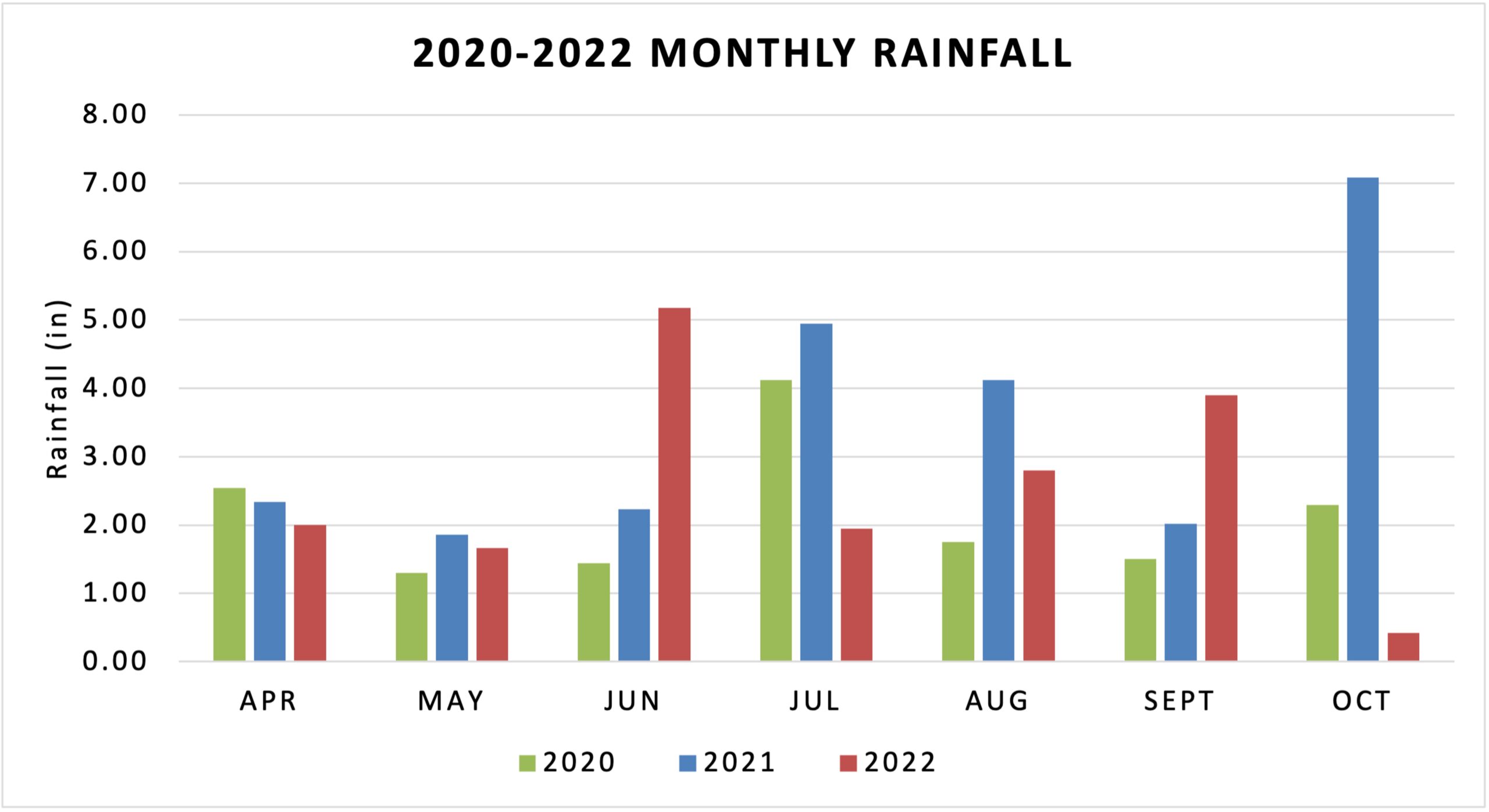
Credit: Cornell Cooperative Extension
Many producers decided to pick grapes early to avoid any potential rot or loss of flavor in their smaller, more coveted crops. Perhaps some were still scarred from the rains and disease pressure of the previous year’s unforgiving harvest. As such, they also found themselves with extra time in the fall thanks to an early pick.
It turns out disease pressure was actually relatively low in 2022. October was strikingly dry, with the lowest monthly rainfall total on record in 21 years (.42”). Those able to let their grapes hang on the vines another month enjoyed the luxury of time to further concentrate flavor.
2022 is not short on quality despite the erratic, unpredictable weather.
A strong backbone of acidity showed in the Rieslings especially. The wines are balanced by fruit, and in some cases, residual sugar is left behind after fermentation. The Rosés were light-bodied and refreshing. And both demonstrated a range of moderate to fully-developed fruit flavors driven by vineyard location and harvest date.
Though many were in tank at the time of this report, the Cabernet Franc offerings were particularly captivating–full of vibrant color, energy, and body. Any additional hang time through October shows, with red cherries and strawberries are already singing.
While 2022 seems reflective of a great year for Cabernet Franc, all three wines were a compelling glimpse at the good that can be derived from stress.
The excellent 2020 spring growing season facilitated the establishment of buds and clusters for the 2021 vintage. The 2020/2021 winter did not cause any significant damage to buds, so conditions were set for a potentially large crop of grapes in 2021.
In many respects a vineyard is but a very complex and expensive garden. Vines require the appropriate regime of sunlight, warmth and water to produce ripe fruit. Not really any different from a garden. Over the course of a vintage, producers track the accumulation of warmth and rainfall and the development of shoots, buds, flowers and grape clusters. These observations are used to make vineyard canopy and crop management decisions.
Monthly Growing Degree Days (GDD) provides a measure for assessing the warmth of a vintage (Chart 1). The vintage can then be compared to the Long Term Average (LTA) and in this case a 48 year LTA. Cumulative annual GDD (Chart 2) shows that overall, 2021 was somewhat warmer than average. Especially the ripening months from August through October.
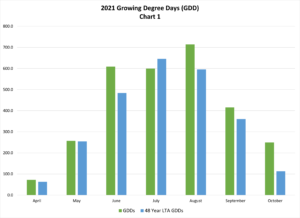
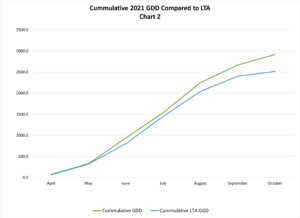
Chart 3 shows the monthly rainfall received in the Finger Lakes during 2021. Averages can be deceiving. April, May and June were dry. Consider how wet July and August were and most especially October.
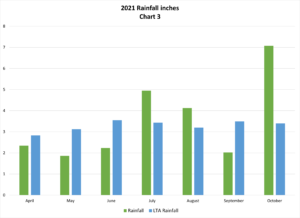
Overall a bit wetter than the average for the last 48 years (Chart 4).
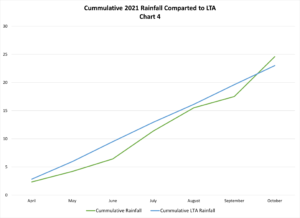
The deviation of GDD and rainfall data from Long Term Average can be viewed together as shown in Chart 5. April was close to normal. May was wet. June was wet and a bit warm. Overall spring weather encouraged early bud break and bloom.
July was wet. August was a bit warm and wet. Heavy late rains at the end of August did lead to some berry splitting in a few varieties as well as high humidity. As August and early September played out, many producers acted to reduce the crop in order to more fully ripen a smaller number of clusters per vine.
September was dry though veraison delayed by ten days or so. October was very warm and very wet.
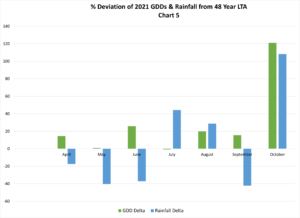
A lot of rain makes vineyard work very challenging. A lot of rain in warm temperatures creates the conditions for significant disease pressure. A lack of warmth and sunshine delays ripening. By the beginning of October most vineyard managers were taking active measures to control disease pressure and to orchestrate harvest logistics such that a large crop could be harvested in optimal condition. This included extra passes in the vineyard to drop damaged fruit.
The 2021 month of October was very challenging with high humidity. Winemakers were working diligently to sort grapes and deal with preventative measures on the crush pad.
There was one other factor at play during the 2021 vintage. On average, the nights were warmer than usual. This has the effect of reducing acidity in some varieties.
Vintage variation is an inherent characteristic and a strength of the cool-climate growing circumstances of the Finger Lakes. The fortuitous combination of applied research and support from Cornell & the Finger Lakes Grape Program; the growing reputation of the region’s wines, and the developing and consequential technical abilities for vineyard managers and winemakers to recognize and deal with challenges, enables Finger Lakes wineries to produce noteworthy wines even in challenging vintages such as 2021.
2020 Vintage in the Finger Lakes
December 23, 2020
The 2019-2020 winter was quite mild with virtually no bud damage to vines. April and May were cooler than long term average with consequential delayed bud break. May 8-9 & 12-13 frost events (temperatures of 28 F) resulted in bud damage with the potential for reduced crop size.
May & June were very dry (~ 60% below average). July was warmer than average (~ 12%) so by the end of June accumulated Growing Degree Days (GDD) was close to average. Even though July rainfall was 20% above average, August, September and October were very dry. Total rainfall for the growing season was a scant 14.9 inches whereas the total long term average was 90.6 inches.
August and September were close to average GDD and by the end of October, accumulated GDD were close to the ten year average (October was a bit cooler).
The story of the 2020 vintage is best understood within the context of the droughty dryness of May & June, and August through October. However the geographic variation of rainfall in the Finger Lakes is well recognized. In 2020, variation in vineyard crop volumes from one vineyard to another is partially due to the variance in rainfall and related smaller berry sizes, and partially to the frost episodes in May. Certain vineyard sites with vines having access to ground water will have performed very well indeed.
Overall disease pressure was virtually absent providing growers with the luxury of time to manage harvest operations. Ripeness as measured by sugar accumulation (brix) was excellent. Temperatures and exceptional diurnal variation (warm days, cool nights) has favored the retention of acidity; freshness being a hallmark character of Finger Lakes wines.
Mid December tastings of the 2020 vintage show remarkable palate weight, varietal clarity and charm. Freshness has been retained and alcohol levels are for the most part, moderate. Overall, 2020 promises to be a very strong and complete vintage for both red and white wines. A sense of ripeness, strength and balance.
This report was compiled from data provided from Cornell’s Finger Lakes Grape Program, and extensive tastings with winemakers of member wineries of the Finger Lakes Wine Alliance. Our thanks and appreciation for their generous assistance.
2019 Vintage in the Finger Lakes
March 6, 2020
The Finger Lakes experienced a moderate 2018-2019 winter with little damage to buds. That meant that vine pruning decisions were simplified; there being no specific need for additional canes to ensure a full crop.
2019 was a coolish vintage with Growing Degree Days (GGD, base 50 F) down 9% from a ten year average. Since May was cold (-38% GDD) and wet (+26%) budbreak and bloom were delayed. This phenological fact became a source of anxiety for growers as the days to veraison is closely linked to budbreak and bloom.
The summer months were close to normal for heat accumulation with July being especially dry & sunny. Overall the fall was somewhat cooler than average, but a wonderfully dry and sunny September brought ripening forward. Growers could leave grapes on the vine to ‘hang’ and were relieved to see key ripening parameters such as acid levels declining and pH levels creeping up.
The 2017 crop was much larger than normal (and quite a surprise), 2018 much smaller than normal, and 2019 close to normal. This bodes well for 2020 since vineyards will not be subject to stress from heavy crops.
Whites wines exhibit the freshness of a cool vintage. Rieslings are generally tight, minerally with more citrus fruit. The wines have good weight and will cellar very well. Wines that have been longer on lees have broader mouth feel and palate weight.
Red wines have considerably more tannin structure that was the case for 2018 or 2017. The colors are intense, the fruit crunchy and wines that have completed malo-lactic conversion discernably more accessible. A dry and sunny September has paved the way to wines that are ripe, yet restrained, with the reserved fruit and structure for cellaring. Reminiscent of 2004.
A comparison of weather data for a 47 year average and the more recent 10 year average provides some insight to climate change in the Finger Lakes. Overall, the 10 year period is 9% warmer and 7% wetter than the 47 year average. Spring and fall appear to be warmer. The rainfall data is more challenging to interpret. Spring and summer appear wetter, but September dryer and October wetter.
This report was compiled from data provided from Cornell’s Finger Lakes Grape Program, and extensive tastings with winemakers of member wineries of the Finger Lakes Wine Alliance. Our thanks and appreciation for their generous assistance.
2018 Vintage in the Finger Lakes
November 28, 2018
There are three interrelated factors to consider in assessing a vintage. The weather in terms of heat units (growing degree days or GDD) & rainfall (inches); vineyard operations that produce the grapes and, winery operations that produce the wines. Vineyard operations are performed in response to vine and grape growing conditions and winery operations in response to resulting grape characteristics. In 2018 the weather – vineyard/grape – winery/wine triad were very tightly connected for the vintage and required timely actions and agility on the part of vineyard managers and winemakers. Responsiveness paid big dividends as shown in the resulting wines now in tank and barrel.
Overall, the 2018 vintage was 16% warmer (2882 GDD) than the long-term average (LTA). Rainfall at 24.4 in. was slightly (5%) above the LTA. That data does not come close to telling the story of 2018.
The ripening period from August through October paints a more accurate picture. GDD were 21% above LTA and rainfall 38% above GDD. Mid-August and October were especially wet. In other words, warm and wet giving rise to disease pressure and limited ripening at the very end of the vintage.
In general, the 2017 vintage provided growers and winemakers with a long window within which to make harvest decisions. In contrast, 2018 required vigilance to maintain vineyard hygiene, sharp eyes on fruit condition and rapid response within a relatively narrow harvest window. Timing and selection were the keys to success as most of the 130+ wineries in the FLX have proven.
2018 provided a text book demonstration of winemaking in the vineyard. For example, winegrowers adopted a two-pronged approach of harvesting before the onset of botrytis and dropping undesirable grapes in the vineyard – those not sufficiently ripe and those below acceptable quality – before conducting harvest operations. On the crush pad, winemakers instituted selection processes to ensure clean fruit for fermentations. 2018 was a vintage primarily dictated by quality issues as opposed to ripeness, by acting quickly and not waiting.
Challenging weather most certainly entails a challenging vintage. With the level of vineyard management care and winemaking expertise now practiced in the FLX – a challenging vintage can yield solid wines with typical FLX characteristics as is the case for 2018.
Overall, most varieties were harvested within ripeness parameters and noting the tight selection being practiced, went into clean fermentations. Timing was earlier and shorter and volumes much lower than 2017. The resulting wines are restrained and show finesse and elegance rather than power. They show varietal typicity, are balanced fresh and have modest alcohols. Reds are generally medium bodied, and with typical FLX crunchy red fruit.
The full story of the 2018 is being written in tanks and barrels and has yet to be revealed. January and February will see the emergence of many FLX ´ wines and early whites. Reds must complete secondary malolactic fermentation.
Initial signs are that a challenging vintage in the FLX has been met with determination and success.
This report was compiled with contribution from Cornell’s Finger Lakes Grape Program, extensive tastings, and from commentaries obtained from members of the Finger Lakes Wine Alliance producers and winemakers.
The 2018 vintage assessment will be updated as the wines from the 2018 vintage emerge.
2017 has been a solid vintage in the Finger Lakes. White wines are quite fresh (more so than in 2016) and flavorful. Reds are well structured and expressive with a lot of energy.
The 2015 – 2016 winter was mild. Bud hardiness was such that bud injury was minimal. 2016 was extremely dry so there was some initial concern that the impact of the drought stress on vineyards would carry through to 2017. However, this was not the case. The story of the 2016 – 2017 vintage is best viewed in terms of generally average heat accumulation, but much wetter than average (~ 40%), especially before veraison, with incumbent disease pressure, and a very large crop load for vines to ripen.
The spring (May & June) was a little warmer than average (little or no spring frost damage) with higher than average rainfall (+9%). May and June growing degree days (GDD) were slightly above normal and dry. Growing conditions for a large crop were established.
The summer (July & August) was just a touch cooler than average but very wet (+49% rainfall over average). Especially July with more than twice the average rainfall. These conditions promoted vine vigor (growth in canopy) and increased disease pressure.
Over the past decade as the reputation of the Finger Lakes has grown, winegrowers have demonstrated the awareness and commitment to manage their vineyards and deal successfully with complex growing conditions. This proved to be the case once again in 2017. Primarily by ensuring hygienic vines and clusters and by controlling crop load.
Fall (September & October) were warmer than average (+ 48%). September was warmer and dryer than average. October was much warmer than average and about average rainfall up until a tropical storm just before Halloween. There is no question that the fall ensured the quality of the vintage and produced a very large crop.
In general, the vintage produced grapes with close to average sugars, higher acidities, slightly lower pHs and expressive flavors. In other words, favorable chemistries for typical Finger Lakes styles. Flavor development may be partly due to the length of time most producers left grapes on their vines prior to harvesting.
This report was compiled with major contribution from Cornell’s Finger Lakes Grape Program, and from commentaries obtained from members of the Finger Lakes Wine Alliance producers and winemakers.
2016 was a successful vintage in the Finger Lakes. White wines exhibit typical pure, clean Finger Lakes fruit flavors and balance and red wines are bold and ripe. Wine quality is high and wine volume varies from normal to 10% – 20% below normal depending on varietal and producer.
The 2015/2016 winter was much warmer than normal – with a one-day exception. Feb 14th. Temperatures dropped precipitously and some producers experienced bud damage in a few varieties. With the complex landscapes and vineyard aspects, the impact varied with vineyard location and variety. Given the developing labor shortages in the region, and the generally very warm winter, many producers had started pruning. Those that had not started or were not completed made adjustments by leaving additional canes with buds to facilitate a full crop.
The spring was cool (no frost episodes) with lower than normal rainfall. May and June growing degree days (GDD) were slightly above normal and dry.
The summer was the driest and warmest in 50 years – and drought conditions developed in many vineyards. GDD at 2854 for the vintage was 15% above the 40 year average. Drought stress contributed to less vigorous canopy development and lower berry size and weight. Rainfall at 15.7 inches was 31% below normal. The combined effects of the Feb 14 cold snap and the dry conditions mitigated the impact of the heat such that in general, grapes were harvested without the excessively high sugar levels. In most instances grapes were surprisingly close to average brix levels.
The drought affected young vineyards and they required irrigation. Many producers dropped some or all fruit in such vineyards especially those that were stressed. Since the majority of vineyards lack irrigation, this was accomplished at great effort, manually. Vineyards on shallow soils (a minority in the FLX) also suffered with reduced production.
The dryness and lack of moisture considerably reduced disease pressure and provided an ideal condition for growing and harvesting clean fruit of high quality. In some vineyards the volume of a few varietals was reduced by 10% to 20%.
In 2016 full flavor development was delayed in some vineyards. However, the harvest started about a week earlier than usual (since some canopies were shutting down) and was completed (mostly) by Oct 17 – 19 when the rains came. With half the month over, October still experienced 7 inches, more than twice the long-term average rainfall for the month.
In general, the vintage produced high quality, clean grapes with close to average sugar levels, slightly lower acidities, and slightly higher pHs. Some winemakers made slight acidity adjustments to some fermentations. Flavors are clean and pure – since little or no disease was present. It is early days yet, but 2016 is looking like a vintage with good white and exceptional red wines.
This report was compiled from information provided by the Finger Lakes Grape Program, supplemented by commentaries from members of the Finger Lakes Wine Alliance producers and winemakers.
———–2016 Temperature & Rainfall Charts ————-
The 2015 vintage was a bit warmer (8%) than the long-term average and total rainfall was a bit higher (8%) than average.
The winter for the 2015 vintage (2015 – 2016) was colder than for the previous year (that was also a cold winter). Two cold winters in a row had an impact in the Finger Lakes causing growers to invest more labor in vineyards as vineyard management practices were adjusted to account for injured buds and vines.
The very cold winter also meant that the vines were even more winter hardy than they usually are (assessment based on testing conducted by extension personnel from Cornell University). As a result, while a number of vineyards did sustain winter injury for a second or third straight year, many vineyards ended up with close to normal crops for the year.
Spring (April and May) was a lot warmer than average (+43%) due to a very warm May. The spring was also a bit drier than average (-8%).
The summer months (June, July, August) were just slightly cooler than average. A gully-washer June had twice the usual rainfall so vineyardists needed to stay vigilant in dealing with higher disease pressure. However, the wetter June was followed by a drier July and a much drier August drying out vineyard soils and setting a strong stage for the harvest.
August, September and October – the period of veraison (that occurred a little earlier than usual), ripening and harvest – was somewhat warmer and drier than average. A much warmer September (+42%) meant that the heat units for this critical period finished 10% above average. The dryer August and much drier October (38% less rain) really helped ensure a healthy, ripe crop with typical Finger Lakes freshness.
The additional heat in May and subsequent weather pushed the harvest to being seven to eight days early.
The 2015 vintage demonstrated with great clarity the flexibility and adaptability that Finger Lakes winegrowers are practicing in the vineyards to respond to vintage variation.Overall, the 2015 vintage wines have more definition, freshness and weight than was the case for 2014 (also a strong vintage).
Our thanks to the Cornell Cooperative extension program for their support in providing information for the FLWA summary of the 2015 vintage.
The temperature variations of the early part of the 2013/14 winter featured warm periods that de-acclimated vines to some extent. Low temperatures in January that followed damaged vinifera buds. The winter remained cold. Damage was most severe in the northern ends of Seneca and Cayuga Lakes. Consequently many growers modified pruning to leave additional buds and canes. In general terms, crop volumes were down in 2014 quite considerably although the degree varied by variety and specific vineyard situation. For example, Riesling at harvest came through much better off than had been expected in the spring.
A late spring was followed by an indifferent summer. April was a bit below the long-term average summation of growing degree-days (GDD). May and June were a bit above normal but then July and August were cooler – the season to the end of August being about 3% below normal. September GDD was just slightly more than normal and October was about 37% warmer than normal. Overall 2014 heat accumulation (2457 GDD) finished close to the long-term average (2478 GDD). The story of the vintage lies with rainfall. Rain in April, May and June was slightly (2%) above the long-term average (9.61 in) for the three months. The heavens opened in July with 7.81 in.; almost three times the long-term average! Disease pressure mounted and required a great deal of attention in the vineyard. While rain in August was about normal – the 2014 season to the end of August was about 26% above long term average (thanks to July). Veraison and ripening were considerably delayed.
The vintage was saved by a mostly dry and sunny September and October. An extremely dry September (0.92 in.) was 74% below long-term average rainfall. October rain was 14% below average. While 2014 rainfall (24.2 in.) finished up with a little above average rainfall (23.1 in.), it was the marvelous September & October (‘catch-up’ weather) of more sun and less rain that provided ideal conditions for ripening. This led to a very compressed harvest – tough on winegrowers with varieties overlapping and long hours on the crush pad.
2014 wines exhibit good weight and clear fruit and are structured and well defined. Finger Lakes Riesling has great freshness and focus. Vintage 2014 is a good, solid Finger Lakes vintage with fresh and expressive reds and whites.
Our thanks to the Cornell Cooperative extension program for their support in providing information and commentary for our summary.
The winter of 2012-2013 was average in terms of cold temperatures and the Finger Lakes did not experience any significant negative extremes. Overall bud damage was very limited (10% and under).
Bud break was close to normal and occurred from the end of April to the beginning of May. Warming occurred slowly with no spring frosts. Conditions were somewhat cloudy and rainy during bloom and fruit set but did not seem to impact fruit set. On average, the growing season was wetter than normal (+15%). These circumstances encouraged shoot growth and increased disease pressure (downy mildew, botrytis).
The excellent conditions during the 2012 vintage encouraged buds leading to a very large crop in 2013. Crop size & weather combined with full canopies meant that producers had to maintain accurate spray programs – but nothing close to the challenges of 2011.
At the end of August the season pivoted and was much drier than normal through early October, the heart of the ripening period – ensuring a sound vintage. The 2013 vintage experienced 2575 GGDs (growing degree days) – just a tad cooler than a ten-year average (2629).
With good vineyard practices the norm, and with some sorting in the field and crush pad, the vintage has produced expressive wines that are medium bodied, balanced with moderate alcohol and good Finger Lakes typicity.
With thanks and acknowledgement to the Finger Lakes Grape Program, Cornell Cooperative Extension.
The 2012 growing season in the Finger Lakes was exceptional. With good fruit set, warm weather and just sufficient rain, a solid crop achieved full ripening. Red and white wines exhibit excellent varietal expression with the reds having the darkest color in years.
Growing degree day accumulation was almost identical to 2010, the warmest growing season that the Finger Lakes has had in over 40 years. As of August 30, the region had accumulated as many growing degree days as it normally does by the end of October. Rainfall totals were below average in most months as well, particularly in May, June and August, which helped to keep disease pressure low for most of the growing season. While the area did go through a stretch of several weeks with very little rainfall in late May, June and July, most vineyards were not as significantly impacted by drought stress as many other types of crops in other parts of the East and Midwest.
The warm weather meant that the vineyards were ahead of schedule in terms of bloom, veraison and harvest. Most varieties were picked 2-3 weeks earlier than normal, and because disease pressure remained low even with the return of some rain during harvest, later ripening varieties were picked on full fruit characteristics and flavor development. Disease pressure remained low even with some rain during the very tail of harvest.
As can be anticipated in a warm year, brix development was higher than normal in a number of varieties. Good acidity levels are an important component for many Finger Lakes wines, especially Riesling. Acidity levels in fruit can be problematic in warm years like 2012 but this was not especially the case.
Vintage 2011 in Finger Lakes has yielded very pleasant wines for current consumption; with particular strength in Riesling and other aromatic whites including Pinot Gris and Gewürztraminer. Wines exhibit Finger Lakes balance with lower than average acids being compensated by lower pH thus retaining the impression of crispness.
A mild winter followed by a cool, moist spring established conditions for above average yields. July and August were generally hot and dry, providing advantage to vineyards with access to natural moisture or irrigation. September and October were average other than consistent cloud cover and rain episodes that kept potential alcohol (sugar accumulation) to modest levels.
Vineyard and cellar practices required continuous adjustment, especially in the weeks leading up to harvest. With botrytis pressure, crop selection strategies were especially significant in assuring quality. Producers that practiced sound crop management and delayed harvesting varieties such as Riesling and Cabernet Franc to the end of October were well rewarded by a much drier and warmer period with superior results.
In general, the 2011 vintage has demonstrated the growing maturity and quality drive of Finger Lakes vineyard and winery practices with lighter, charming & expressive wines.
